Pu Erh Tea Leaves
Pu Erh tea, with its origins in the Yunnan province of China, boasts a rich history intertwined with trade and cultural practices. Your journey through the world of Pu Erh begins here.
Origins and Cultural Significance
The roots of Pu Erh tea stretch back to the Eastern Han Dynasty (25–220 CE), where it began as a form of dark tea, uniquely processed and distinct from other tea varieties. Yunnan's diverse ethnic groups have cherished Pu Erh for centuries, integrating it into their social rituals and medicinal practices. This tea has also played a pivotal role in the historical Tea Horse Road, where it was bartered for Tibetan horses, bolstering a cultural exchange that shaped regional relationships.
- Region of Origin: Yunnan Province, China
- Earliest Records: Eastern Han Dynasty
- Cultural Practice: Social rituals, health remedies
- Trade Significance: Tea Horse Road, exchange for Tibetan horses
Historical Production Methods
Historically, the production of Pu Erh tea involved a series of distinctive steps to create its unique flavor profile. After plucking, the leaves were pan-fired, a process used to halt oxidation. Then, they underwent a fermentation stage, where bacterial and fungal cultures played a vital role in shaping the tea's character. The final step, pressing the leaves into cakes or bricks, not only facilitated easier transport along rugged trade routes but also catered to the aging process that Pu Erh tea is renowned for.
Bestsellers
- Step 1: Plucking of tea leaves
- Step 2: Pan-firing to prevent oxidation
- Step 3: Fermentation with microbial cultures
- Step 4: Pressing into cakes or bricks for transport and aging
Your comprehension of Pu Erh tea's history is now rooted in an authentic past, understanding the intricacies of its production and deep cultural significance.
Processing of Pu Erh Tea
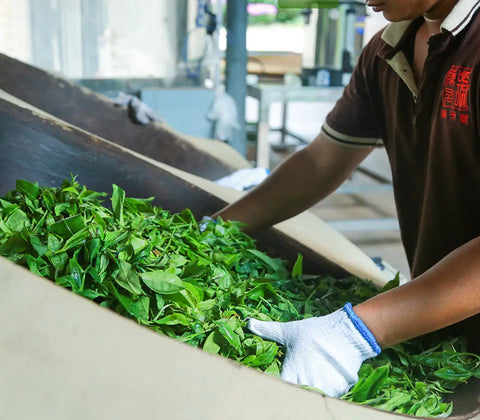
Pu Erh tea is distinguished by its unique processing method that involves fermentation and aging, contributing to its complex flavor and potential health benefits.
Harvesting
Your first step in the production of Pu Erh tea involves the careful picking of Camellia sinensis leaves, predominantly from the Yunnan province of China. Only the finest young buds and leaves are selected, typically during the spring season when the quality is considered optimal. Harvesting is often done by hand to ensure the preservation of leaf integrity.
Fermentation Process
Once harvested, the leaves undergo the fermentation process, which can be classified into two types:
-
- The leaves are lightly pan-fired to stop oxidation and then rolled, sun-dried, and steamed.
- Pressed into cakes, these raw leaves are left to ferment naturally over time.
-
- This involves a more accelerated fermentation method known as wo dui.
- The leaves are piled, moistened, and covered to encourage microbial action, which develops over a period of a few months as opposed to years with Sheng Pu Erh.
Aging and Storage
The final stage of producing Pu Erh tea revolves around aging and storage, which is critical for flavor development. Proper storage conditions include:
- Consistent temperature (around 20–30°C or 68–86°F)
- Moderate humidity (60–85%)
- Protection from strong odors and direct sunlight
- Adequate air circulation
Over several months to years, Pu Erh tea deepens in flavor. The duration of aging can vary greatly, with some teas maturing over several decades before consumption. During this time, your tea's character evolves, becoming smoother and acquiring a more mellow, earthy profile.
Types of Pu Erh Tea
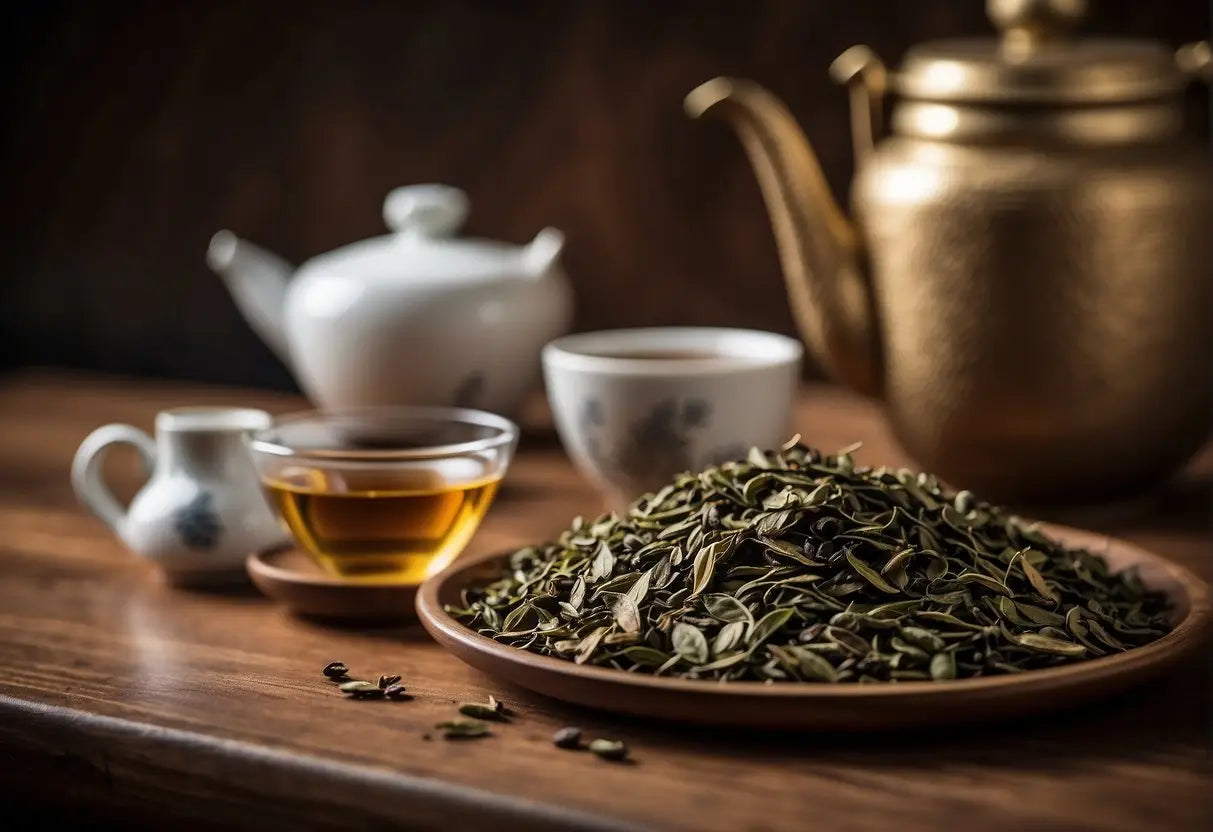
Pu Erh tea is a unique type of fermented tea that originates from Yunnan Province in China. It is classified into two primary types: Raw (Sheng) Pu Erh, which is naturally aged, and Ripe (Shou) Pu Erh, an accelerated fermentation process.
Raw (Sheng) Pu Erh
Raw Pu Erh, or Sheng Pu Erh, undergoes a traditional process that involves:
Lao Ban Zhang
- Sun-drying freshly picked leaves.
- Steaming and compressing into cakes, bricks, or other shapes.
- Natural aging over time, allowing a gradual fermentation.
Sheng Pu Erh can be consumed young or aged, with the flavors evolving over years. The taste profile shifts from fresh and astringent to mellow and complex as it matures.
Ripe (Shou) Pu Erh
Ripe Pu Erh, or Shou Pu Erh, was developed in the 1970s to mimic the aging process of Sheng Pu Erh:
- After initial processing, the leaves undergo a "wet piling" phase.
- This involves controlled humidity and temperature to accelerate fermentation.
- The process takes several months, producing a darker, richer tea.
Shou Pu Erh has an earthy profile with less astringency, providing a smoother and often quicker introduction to aged tea flavors.
Tasting Notes

When you sip Pu-erh tea, your palate is greeted by a complexity of flavors and aromas that are deeply rooted in the tea's unique fermentation process and aging.
Flavor Profile
Ripe (Shou) Pu-erh:
- Earthy: A distinct taste resembling the damp forest floor after rain.
- Smooth: Often velvety on the tongue with a mellow finish.
Raw (Sheng) Pu-erh:
- Astringent: Can be sharp with a slight bitterness that mellows with age.
- Floral: Younger Sheng Pu-erhs may have a flowery undertone, softening as they age.
Aroma Characteristics
Ripe (Shou) Pu-erh:
- Mushroom: A deep, woodsy scent that is comforting and grounding.
- Camphor: Some aged Shou Pu-erhs develop a cooling, menthol-like quality.
Raw (Sheng) Pu-erh:
- Fresh: Younger Sheng Pu-erhs exhibit grassy and herbal notes.
- Fruity: With aging, they gain complexity and might exude plum or apple fragrances.
Health Benefits and Claims
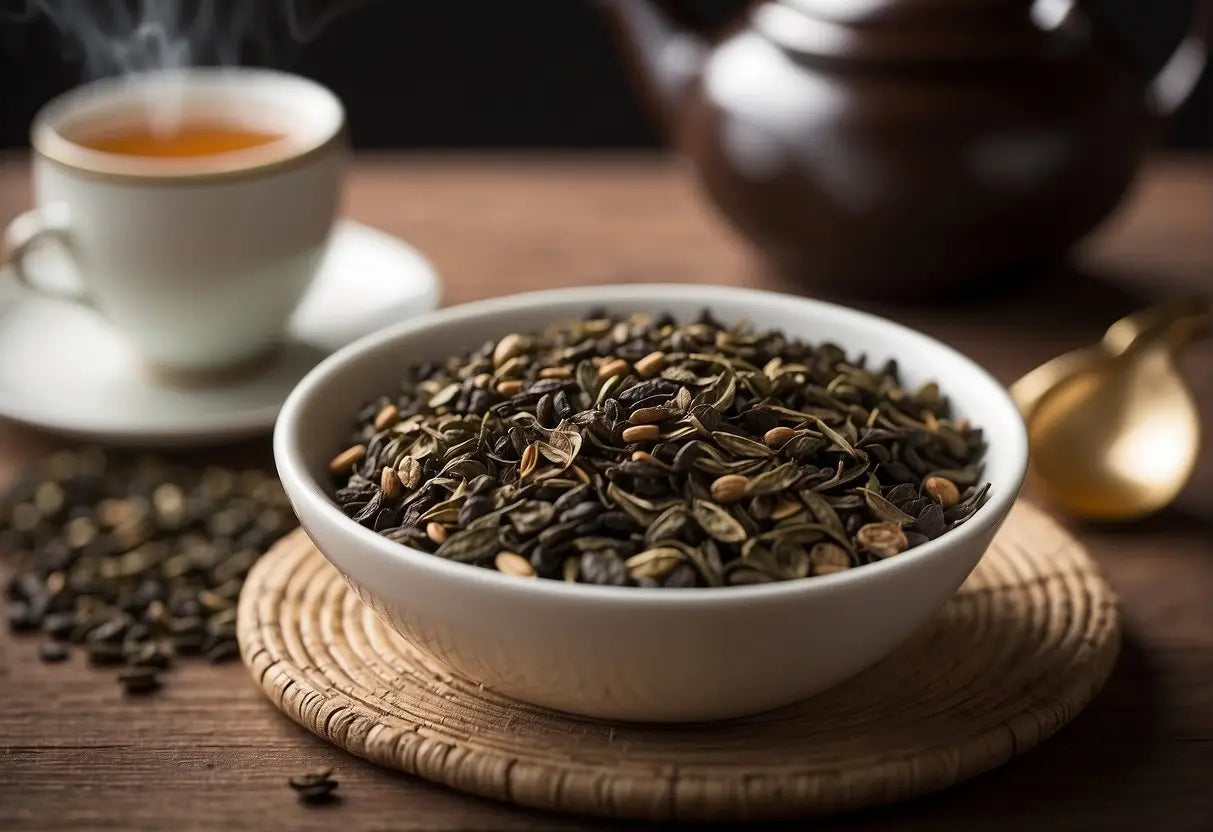
Pu-erh tea is often consumed for its potential health benefits, which include aiding digestion, improving heart health, and helping with weight loss. Research into these areas provides insights into how this traditional beverage might support your wellbeing.
Digestive Health
Your digestive system may benefit from Pu-erh tea. It contains natural microorganisms that aid digestion by breaking down foods and helping with nutrient absorption.
Heart Health
Studies suggest Pu-erh tea can influence cholesterol levels, potentially reducing bad LDL cholesterol. It's rich in antioxidants which are thought to support overall heart function.
Weight Loss
Pu-erh tea is commonly associated with weight loss. Its consumption could boost your metabolism, helping your body to burn fat more efficiently. It's also believed that Pu-erh may help to suppress the synthesis of new fat.
Brewing Techniques
Proper brewing is essential for experiencing the full depth of flavors in pu-erh tea. These techniques vary from traditional methods steeped in history to modern practices that prioritize convenience and consistency.
Traditional Brewing Methods
Gongfu Cha: The traditional method, known as Gongfu Cha, involves a series of short infusions using small teapots or gaiwans. Follow these steps for the Gongfu technique:
- Rinse: Pour hot water into the teapot or gaiwan with the pu-erh tea and immediately discard the water. This cleanses the tea leaves and awakens their aroma.
- First Brew: Add hot water at around 95°C (203°F) and steep for 5-10 seconds before pouring into a serving pitcher or directly into cups.
- Subsequent Brews: Increase the steeping time by 5-10 seconds for each additional infusion. You may repeat this process up to 10 times or until the flavor fades.
Note: It's recommended to use between 5-7 grams of tea per 100ml of water.
Modern Brewing Practices
Tea Infusers and French Presses: For those seeking convenience, modern tools like tea infusers and French presses can be used for brewing pu-erh tea. The procedure is straightforward:
- Place the tea leaves in the infuser or press.
- Pour water just off the boil, approximately 96°C (205°F), over the leaves.
- Allow the tea to steep for 3-5 minutes, depending on your taste preference, before removing the infuser or pressing down the plunger.
Tip: Start with a ratio of 1 gram of tea per 15-20ml of water and adjust to your liking.
Selecting Quality Pu Erh Tea
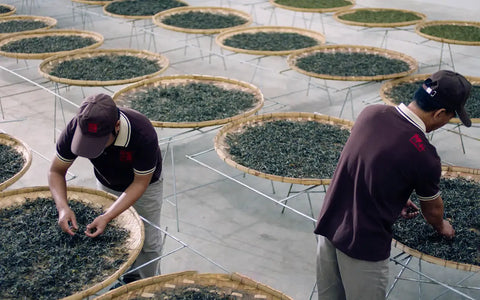
When selecting a quality Pu Erh tea, you need to assess the leaf grade and identify signs of authenticity. Accurate information on these aspects ensures you make an informed purchase.
Leaf Grade and Quality Indicators
Leaf Appearance: High-grade Pu Erh should have whole leaves with a consistent color. Immature leaves or excess stems indicate lower quality.
Aroma: Expect a rich, pleasant smell. A musty or sour odor suggests poor handling or storage.
Brew Color: A vivid, transparent brew color, which ranges from yellow to deep amber, is a sign of quality.
Taste: Look for a smooth taste with depth. Astringency should be balanced and not overwhelming.
-
Whole Leaves: Superior tea is often made from the larger, more mature leaves.
-
Leaf Consistency: Ensure the tea has uniform leaf pieces and minimal dust or broken fragments.
-
Brightness: Quality leaves often have a certain brightness or sheen indicative of careful processing.
Identifying Authenticity
Region and Producer: Genuine Pu Erh comes from Yunnan Province in China. Verify the producer for an established reputation.
Certification: Seek certifications like "Protected Designation of Origin" (PDO) which validate the tea's origin.
-
Wrappers and Labels: Authentic Pu Erh usually comes with detailed wrappers indicating the tea's origin, production year, and grade.
-
Serial Numbers: Many premium Pu Erh teas have serial numbers you can verify online for authenticity.
Use these indicators to carefully select your Pu Erh tea, ensuring it meets high standards of quality and authenticity.
Pu Erh Tea Storage Guidelines
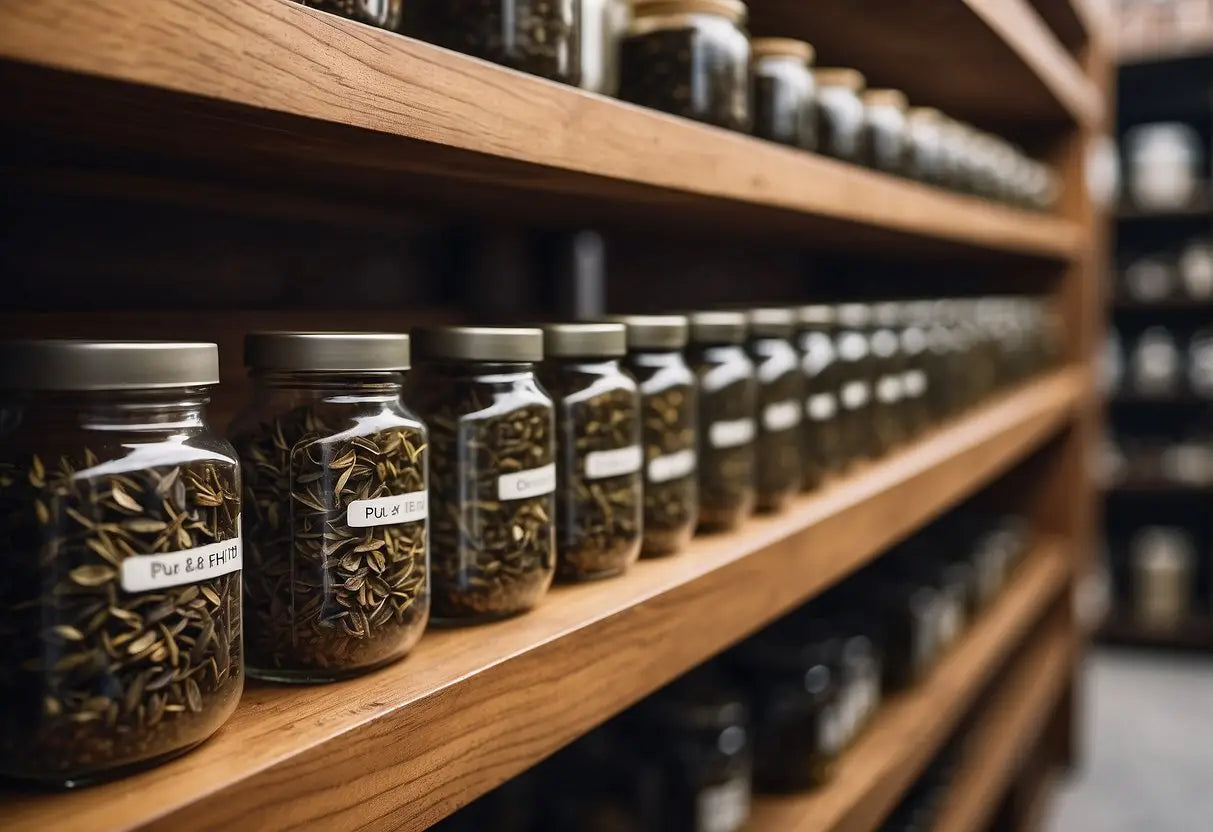
Proper storage of Pu Erh tea is crucial for its flavor development. Here are some guidelines to help you maintain the quality of your tea:
Environment: Store your Pu Erh in a cool, dry place away from strong odors and sunlight. Optimal temperature ranges from 20°C to 22°C (68°F to 72°F) with a humidity level of 60-70%.
Containers: Use either natural materials like wooden boxes or clay jars, or specially designed Pu Erh wrappers and tea cakes containers. Your container should be well-sealed to prevent exposure to odors.
Airflow: Your Pu Erh needs adequate airflow to age properly. However, avoid direct drafts and overly dry conditions that can halt the aging process.
Moisture: Guard against excessive moisture that can lead to mold. If you live in an extremely humid area, consider using a dehumidifier.
Avoid Contamination: Keep your Pu Erh away from substances with strong odors such as spices, as tea leaves absorb scents easily.
Regular Checks: Inspect your Pu Erh periodically to monitor its condition and ensure there is no mold or unwanted odors.
| Do | Don't |
|---|---|
| Store in natural material containers | Expose to light and odors |
| Maintain stable temperature and humidity | Store in airtight containers – tea needs to breathe |
| Check on your Pu Erh periodically | Allow tea to get damp or moldy |
By following these guidelines, your Pu Erh tea will age gracefully, developing deeper and more complex flavors over time.
Cultural Practices and Ceremonies
In the culture surrounding Pu-erh tea, you can find a rich tapestry of traditions and ceremonial practices that reflect its historical significance in Chinese society. For centuries, Pu-erh tea has been deeply interwoven with social rituals and has often been presented as a valuable gift to show respect and honor.
During traditional Chinese tea ceremonies, your mannerisms, and the tools you use are as significant as the tea itself. You might witness the Gongfu tea ceremony, which involves a series of precise steps designed to bring out the best flavor of Pu-erh tea. The steps you would follow include:
- Warming the Utensils: Pouring hot water into the tea ware to prepare them for the brewing process.
- Rinsing the Tea: Briefly washing the Pu-erh tea leaves with hot water to remove any impurities and awaken their flavor.
- Brewing the Tea: Steeping the tea leaves for a specific time, which varies depending on the type of Pu-erh and personal preference.
In addition to the brewing process, the way you serve Pu-erh is also done with care. Small cups are often used, and the tea is poured in a circular motion to ensure an even distribution of the tea's essence.
Your engagement in these ceremonies is not merely about drinking tea but about embracing a moment of tranquility, experiencing a connection with history, and participating in a practice that promotes mindfulness and social bonding. The tea itself serves as a bridge between the past and present, allowing you to immerse yourself in a timeless cultural custom.
Frequently Asked Questions
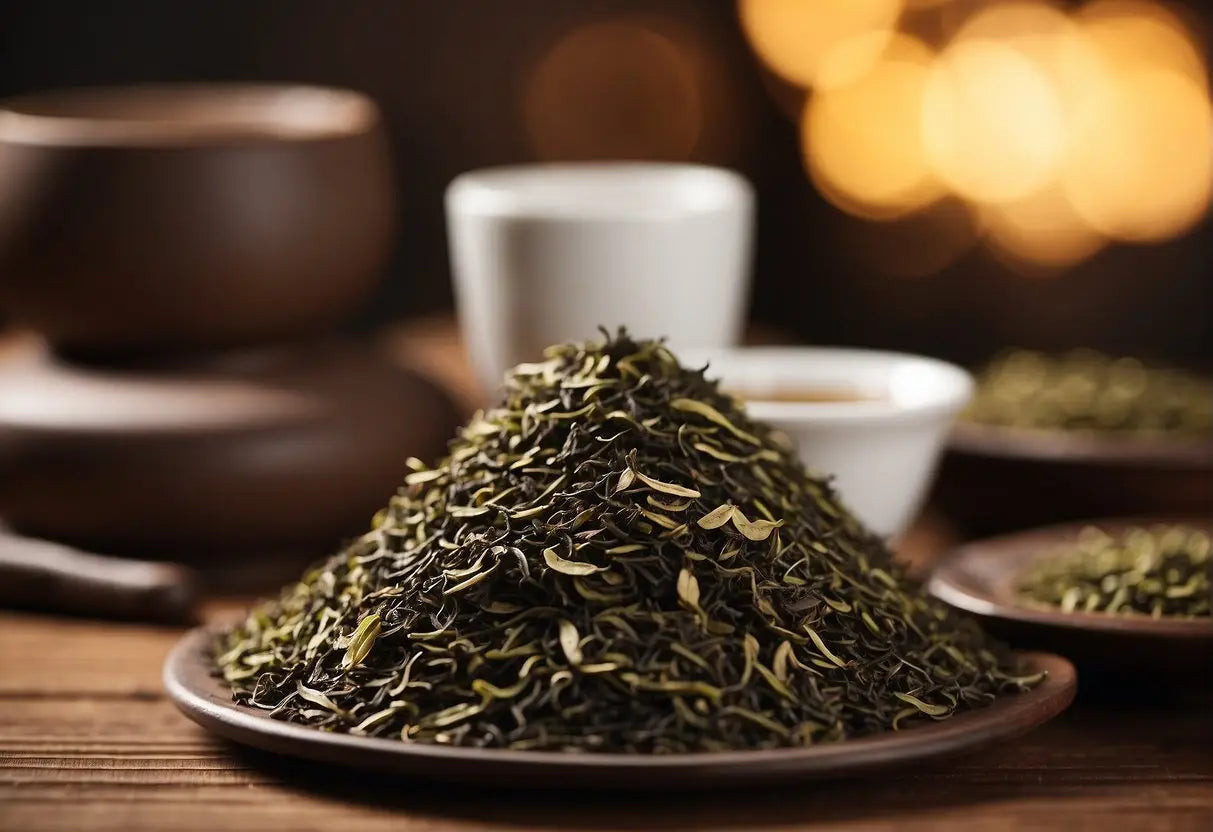
Pu-erh tea is a unique beverage with a range of intriguing characteristics. This section provides clear, concise answers to some of the common queries regarding Pu-erh tea's health benefits, acquisition, taste, safety, pricing, and caffeine content.
What are the health benefits associated with drinking Pu-erh tea?
Pu-erh tea is believed to aid digestion, support weight loss, and reduce cholesterol levels due to its fermentation process. Its antioxidant properties may also contribute to overall health enhancement.
Where can one find high-quality Pu-erh tea for purchase?
High-quality Pu-erh tea can be sourced from specialty tea shops or online retailers dedicated to premium teas. It's important to seek vendors who provide information about the tea's origin, age, and production methods.
How does Pu-erh tea compare to other black teas in terms of flavor and properties?
Pu-erh tea often has a deeper, earthier flavor than other black teas. It is also distinct in its post-fermentation process, which imbues it with a complex profile and potential probiotic properties.
Are there any potential side effects or risks from consuming Pu-erh tea?
Like other teas, Pu-erh tea contains caffeine, and its consumption should be moderated accordingly. Rarely, some individuals may experience digestive discomfort due to the tea’s fermentation.
Why is Pu-erh tea often priced higher than other types of tea?
Pu-erh tea commands a higher price due to its lengthy and unique fermentation process, aging potential, and the traditional craftsmanship involved in its production.
How much caffeine content is typically present in Pu-erh tea compared to other caffeinated beverages?
Pu-erh tea generally contains less caffeine than coffee but may have similar levels to other black teas. On average, an 8-ounce serving can contain about 30-70 milligrams of caffeine.
← Older post Newer post →











